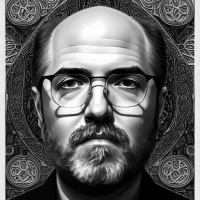Black Mirror: The Star Trek References in USS Callister
The Black Mirror episode, “USS Callister,” has clear nods to the original Star Trek series that combine nostalgia with obsession.

There’s no mistaking the likeness of the USS Callister from the season 4 Black Mirror episode of the same name to the iconic USS Enterprise from the original Star Trek series of the 1960s.
Robert Daly’s vintage collection of all six seasons of the fictional Space Fleet series may exceed Gene Roddenberry’s three years of swashbuckling space drama, but the recognizable references to the source of inspiration deserve a closer look. Upon careful examination, here are the most obvious homages.
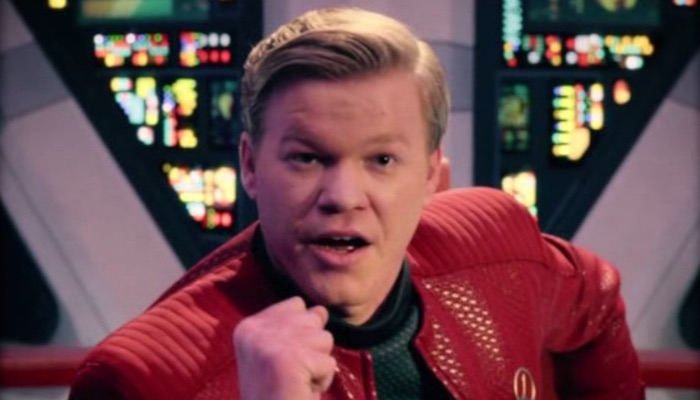
The Captain Kirk demeanor
Jesse Plemons’ performance is admirably distinct as he enacts both the more confident captain of the Callister vessel and the downtrodden CTO of the Callister company, but when he’s in character as Captain Daly, he’s almost channeling William Shatner as James T. Kirk. While Kirk may not have gone so far as to embrace all of his female crew members in a celebratory kiss after each mission, one trademark move that was hard to miss was Captain Daly’s delivery of the line, “Fire!” as he commanded his weapons officer to disable the villain’s ship, fist clenching under his chin with dramatic punctuation. Classic Kirk!
It’s no surprise, then, that Plemons had a dialect coach to master the signature voice. In an interview with THR, episode director Toby Haynes explains, “Jesse would say, ‘You let me know if you want to turn the dial up on Shatner.’ We did it one or two times where he went full Shatner, like when he says ‘fire’ in the opening. That’s straight out of Star Trek VI: The Undiscovered Country. I love those movies. I’m quoting my heroes. So it comes from a place of love.”
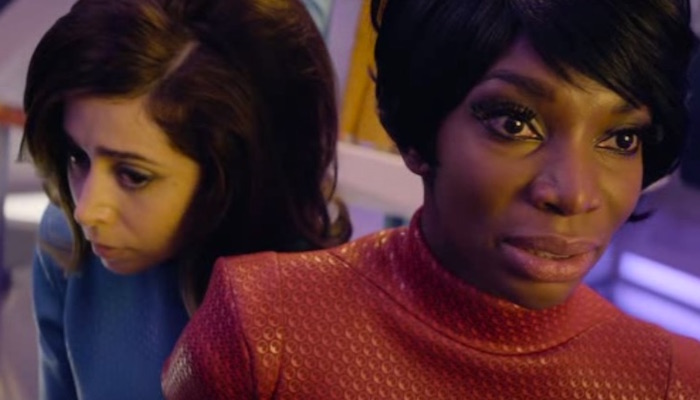
Uhura and 60s fashion
There’s no doubt that Michaela Cole’s communications officer, Shania Lauer, is directly modeled after the pioneering performance of Nichelle Nichols as Lieutenant Uhura in the original Star Trek, right down to the long, fake eyelashes. According to Coel in speaking with Digital Spy, “The eyelashes weighed a ton each. The costume was no respecter of your bladder. If you needed to pee it was like, well, you should have done that an hour ago.”
As soon as the new crew member cloned from Nanette Cole’s DNA arrives, her beehive hairdo makeover is immediately apparent, referencing the 60s origins of Star Trek and apparently Space Fleet as well. Daly does, after all, tell Cole that the show is from “before your time; before my time actually.” And while the midriff-baring uniforms aren’t directly modeled after anything from Star Trek, the mini-skirts are definitely recognizable as well.
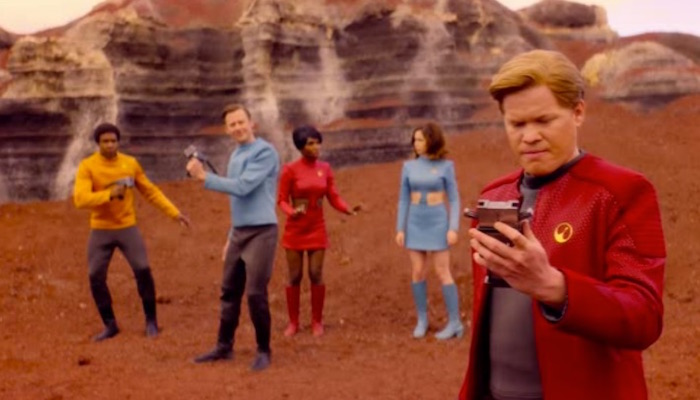
Phasers, tricorders, and transporters
The technology of Star Trek has been imitated by legions of space dramas that came after it, both on television and in film, and Black Mirror isn’t about to break that trend. Even though helmsman Packer points out to Cole that their guns don’t work, Daly’s very tricorder-like omnicorder is instrumental in the crew’s eventual escape plan. And of course the de-materialization of the away team as they head to the planet is so ingrained in our collective cultural memory, no explanation of the transporter is needed. Hyperspace becomes white space and photon torpedoes turn into photon volts, but it’s all a familiar lexicon.
A favorite tongue-in-cheek use of technology, however, comes from Lauer as she acclimates Cole to her new position as science officer just after Daly has tortured her into compliance with his obsessive fan drama. As Daly asks Cole for a signal triangulation, Lauer whispers to her, “It’s any button. They’re all the same.” One can’t help but think of how earnestly Star Trek crew members likewise operated their nonsensical instrument boards.
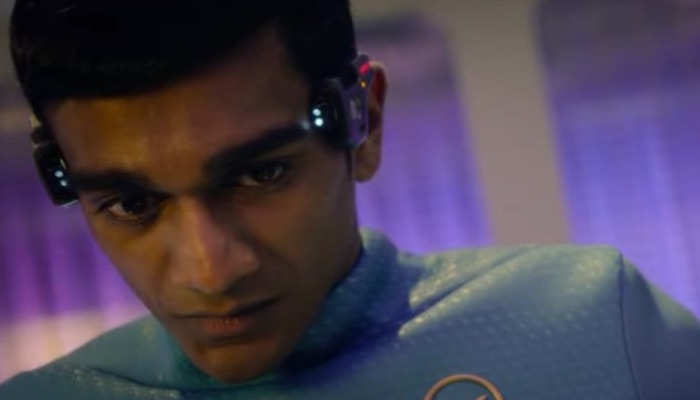
Character likenesses
Is the villain Valdack exactly like the most infamous of Star Trek villains, Khan Noonien Singh? No, but the similarities are certainly there. Jimmi Simpson’s sycophantic Walton is meant to be more worshipful of his captain than anyone on the Enterprise, but his doubtfulness echoes both Bones’ “Dammit, I’m a doctor…” speech patterns and Scotty’s “It’ll tear the ship apart, captain!” a line which Walton mimics exactly in the opening sequence of the episode.
And while LeVar Burton’s Geordi La Forge isn’t from the original series, Dudani’s cybernetic enhancements remind viewers quite a bit of the blindness-conquering visor from Star Trek: The Next Generation. One might even conclude that Tulaska’s blue skin is an homage to the original series’ Andorians or maybe even the infamous green-skinned Orion femme fatale, Galia, reprised by Rachel Nichols in the 2009 cinematic re-imagining.
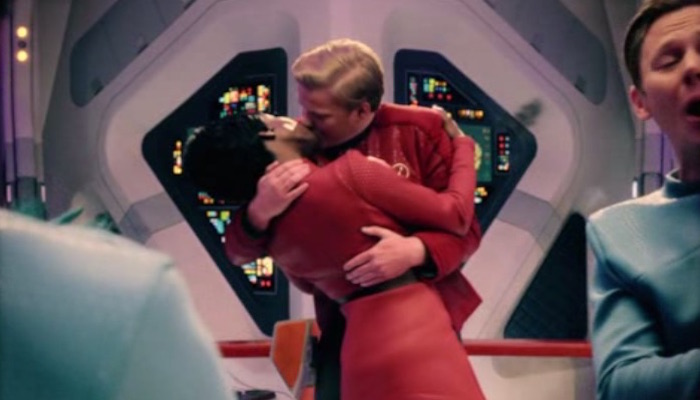
The red shirt
The fact that Lauer and Daly are the only ones wearing red uniforms is no mistake. The “red shirt” has become synonymous with imminent death ever since the original Star Trek famously depicted anonymous, red-uniformed away team members facing their inevitable demise at the hands of alien enemies. Although Lauer doesn’t exactly die, she is the first of those the audience meets to be turned into an alien creature and disposed of, and of course, Daly’s doom, although not predictable in the least, is foreshadowed expertly by the color of his officer’s jacket.
Haynes explains, “I knew the original 60s Star Trek show very well. I was such a fan that I’m kind of reverential about it, so I was happy to play fast and loose with this version… which is why we put Michaela Coel in a red outfit. Michaela had to be in a red outfit because she’s the first of the crew to get killed. On Star Trek, the guy in red always gets nailed. I knew those layers of detail, so I made sure those were elements in there.”
As televised space dramas have evolved on television, a common vocabulary has emerged, and it all started with Star Trek. While the dark elements of Robert Daly’s power trip are pure Black Mirror, the obsessive fan culture surrounding a favorite classic sci-fi series is recognizable to any devotee of the multitude of Star Trek iterations. When viewers see Daly using fandom to conquer his insecurities, they see themselves, and that’s exactly what Black Mirror does best: act as a dark reflection of our own fallibility.
